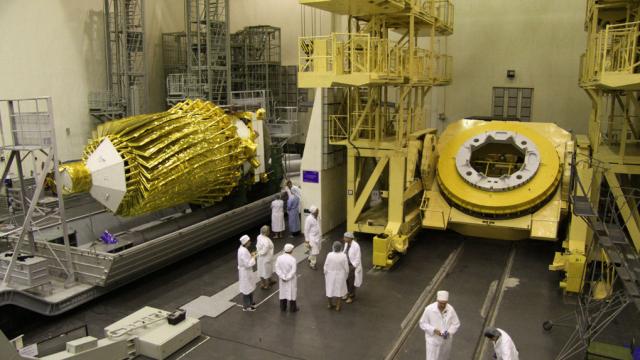Russia’s only orbiting space radio telescope, Spektr-R (RadioAstron), has stopped responding to the spacecraft’s control staff, the BBC reported Saturday, though Astro Space Centre chief Nikolai Kardashev told the BBC that it is still transmitting scientific data.
Spekt-R has a 10m radio antenna dish that works in conjunction with ground-based radio telescopes under an international program. According to the BBC, Roscosmos staff said that the craft — launched in July 2011 on a Zenit-3F expendable carrier rocket — has operated well beyond an original five-year projected lifespan.
It stopped responding on Friday in the UK, despite repeated attempts to re-establish a connection. Spektr-R head of research Yuri Kovalev told the BBC “there is still hope” that Roscosmos staff will be able to restore functionality.
Аппарат «Спектр-Р» запущен в 2011 г., гарантийный срок активного существования истёк в 2014 г. после чего он продолжает решать целевые задачи. Начиная 10.01.2019 г. в работе служебных систем возникли замечания, не позволяющие в настоящий момент осуществлять решение целевой задачи pic.twitter.com/doJxJOnntf
— РОСКОСМОС (@roscosmos) January 12, 2019
“Specialists of the Main Operational Group of Spacecraft Control are carrying out work to remove the existing problems… Beginning with January 10, 2019, problems emerged in the operation of the service systems that currently make it impossible to tackle a targeted task,” Roscosmos wrote in a statement to TASS, Russia’s state-run news agency.
Additional details on the nature of the malfunction were not immediately available.
Russia Beyond, another Russian state media source, reported in 2016 that Spektr-R was expected to continue operating until at least late 2018, with research including galactic nuclei and magnetic fields, quasars and pulsars, and other space projects:
The new program is focused on studies of inner regions of active galaxy nuclei and magnetic fields, monitoring of the brightest quasars, research of water-vapour clouds in space, pulsars and interstellar matter, gravitational experimentation, etc.
The RadioAstron project is based on a ten-meter orbital radio-telescope, the unique astrophysical observatory Spektr-R which forms an integrated radio interferometer with a super-large base together with ground-based radio-telescopes. The observatory is tasked with conducting fundamental astrophysical studies in electromagnetic spectrum bands. RadioAstron has a record discrimination based on distances of up to 350,000 kilometers between telescopes.
While it was first launched in 2011, SpaceNews reported at the time that the craft was originally slated for a launch in 2004 or 2005 “before encountering multiple delays in its construction”.
Another newer radio telescope, the Canadian Hydrogen Intensity Mapping Experiment (CHIME), is still not yet fully operational but made the news last week when it detected 13 new fast radio bursts, mysterious high-energy pulses from unknown, distant sources that have travelled billions of years across the galaxy.
Potential explanations for fast radio bursts include magnetars (rapidly spinning neutron stars), neutron star-white dwarf mergers, collapsed stars, black holes, and — very much in last place in terms of evidence — some kind of artificial, extraterrestrial source.
Among CHIME’s findings was the second-ever reported repeating fast radio burst, though mission staff told Science Magazine this week that they hope to eventually discover hundreds or even thousands of fast radio bursts.
[BBC]
